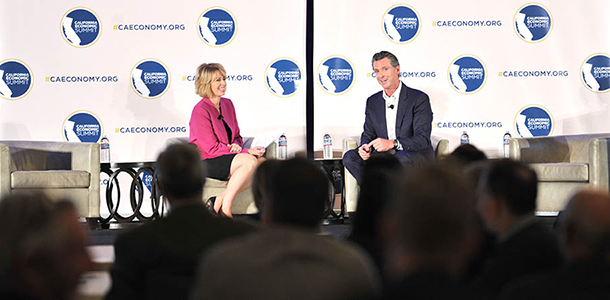
(Photo Credit: Violeta Vaqueiro/CAFwd)
Since the launch of the One Million Challenges in 2016, the Summit has built its prosperity agenda around these multi-year initiatives to expand the state’s pipeline of skilled workers, make housing more affordable, increase the reliability of California’s water supplies, and create more livable wage jobs.
With a governor-elect who campaigned on these issues about to take office, it is time to take stock of what’s been accomplished—and to think together about how to put a range of new initiatives into action next year.
The 2018 Summit Playbook outlines proposed agendas for each of the Summit’s Million Challenges. At the 2018 Summit next week in Santa Rosa, nearly 500 public, private, and civic sector leaders will review progress on these efforts—and discuss how to make these plans the centerpiece of the new administration’s prosperity strategy.
(Check out yesterday’s blog to read more about the Summit’s other major initiatives for next year.)
ONE MILLION MORE WORKERS
With the Summit’s support, the state has made significant progress since the creation of the Strong Workforce Program in 2016—and every California region is actively working to align its workforce development system with in-demand jobs.
The Summit plans to build on this success next year to further tailor programs to help low-skilled and low-income Californians. These efforts include supporting implementation of the state’s new online community college, highlighting new models for successful college-employer partnerships, and working with regional groups to expand pathways into livable wage jobs, whether in the gig economy or the health care industry.
ONE MILLION MORE HOMES
While the “One Million Homes Framework” informed the state’s 2017 legislative housing package and the Summit helped support its implementation this year, the Summit has begun to lay the groundwork for more comprehensive action by the new administration—led by a governor who has called for the production of 3.5 million units during his time in office.
Participants in Santa Rosa will review and refine a draft “3.5 Million Homes Framework,” an updated strategy highlighting all of the major elements of state housing policy that can be used to build the housing Californians need—and people of all incomes can afford—while ensuring this new growth is sustainable for local governments, residents, and the environment. This effort has been informed by two efforts supported by CA Fwd this year: a legislative proposal developed the City of Santa Rosa and Sonoma County for accelerating housing production in the wake of last year’s wildfires and a partnership with the McKinsey Global Institute to support the Stockton mayor’s Task Force on Affordable and Workforce Housing, which considered a range of ideas this year for reducing public costs and encourage less expensive housing development.
ONE MILLION MORE ACRE-FEET OF WATER (EACH YEAR FOR A DECADE)
As Californians continue to use more water each year than the state’s infrastructure can sustainably provide, the Summit has worked this year with state and local partners to accelerate regional water sustainability and resilience. These activities include working in two regions eager to improve their strategies for regional watershed management: a pilot project for managing projects across the Russian River watershed that is being used to inform the California Water Plan Update in 2018; and a partnership to quantify opportunities across the Santa Ana River watershed for improving water efficiency, stormwater retention, and groundwater recharge on commercial and industrial property.
The Summit has also partnered with the University of California Agricultural and Natural Resources Division to develop a set of state policy proposals that will encourage investments in ecosystem services, including groundwater recharge. Through the new Elevate Rural CA initiative, the Summit and its partners are working to identify priority actions for bolstering rural water infrastructure and better manage forest headwaters.
ONE MILLION MORE JOBS
Five million Californians are stuck in minimum wage jobs, and as escalating housing and other costs swallow up more of workers’ paychecks, the Summit has made it a priority to support regional partners’ strategies for producing well-paying jobs in promising industry clusters.
The Summit’s jobs goal is driven by a key finding from the 2017 Summit: For every household in every region to have at least one job paying above the poverty line, California needs to create more than one million more livable wage jobs.

